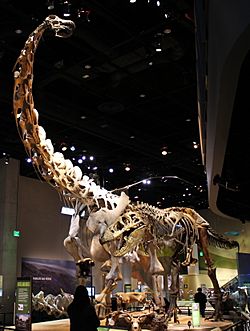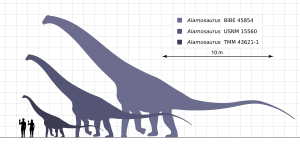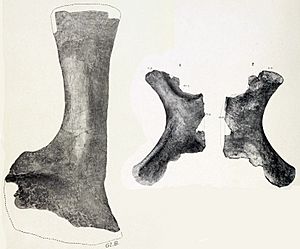Alamosaurus facts for kids
Quick facts for kids AlamosaurusTemporal range: Upper Cretaceous
|
|
|---|---|
 |
|
| Restored skeletons of Alamosaurus and Tyrannosaurus at Perot Museum | |
| Scientific classification | |
| Kingdom: | |
| Class: | |
| Superorder: | |
| Order: | |
| Suborder: | |
| Infraorder: | |
| Family: | |
| Subfamily: | |
| Genus: |
Alamosaurus
|
Alamosaurus was a huge plant-eating dinosaur. It belonged to a group called titanosaurs. This amazing creature lived during the Upper Cretaceous period. That was about 73 to 65 million years ago.
Alamosaurus had a very long neck and a whip-like tail. It could grow to be about 69 feet (21 meters) long. Imagine a dinosaur as long as two school buses! It weighed around 33 tons (30,000 kg). That's as heavy as five elephants!
Scientists have found Alamosaurus fossils in New Mexico, Texas, and Utah. Most of the fossils are parts of skeletons. They haven't found any complete skulls yet. These fossils are very common in the United States Southwest. They help us understand what other animals lived there at that time.
Scientists think that Alamosaurus might have moved to North America from South America. This would have been a big journey!
Contents
Why is it Called Alamosaurus?
Many people think Alamosaurus was named after the Alamo in San Antonio, Texas. But that's not true! The first fossil was found in New Mexico. At that time, no Alamosaurus fossils had been found in Texas yet.
The name Alamosaurus actually comes from the Ojo Alamo Formation. This is the name of the rock layer where the first fossil was found. The word saurus comes from an old Greek word. It means "lizard." You'll see it in many dinosaur names.
There is only one known species of Alamosaurus. It is called A. sanjuanensis. This name comes from San Juan County, New Mexico. That's where the first bones were found. A paleontologist named Charles W. Gilmore named both the dinosaur and its species in 1922. He worked at the Smithsonian Institution.
What Did Alamosaurus Look Like Inside?
Scientists study the bones of dinosaurs to learn about them. The bones in the middle of the Alamosaurus's tail were long. Its backbones had shallow dips or hollows. Other dinosaurs like Saltasaurus and Malawisaurus had similar dips in their bones.
The bones in its front legs were very strong. This helped it carry its massive weight.
How Were Alamosaurus Fossils Found?
Alamosaurus bones have been found all over the southwestern United States. The very first fossil was found in New Mexico. It was in a rock layer called the Ojo Alamo Formation. This rock layer formed during the Maastrichtian stage. This was the very end of the Upper Cretaceous Period.
Bones have also been found in Utah. They were in the North Horn Formation. In Texas, fossils were found in the Black Peaks Formation, El Picacho Formation, and Javelina Formation.
Scientists have found very few skull pieces. They have found some thin teeth. But they haven't found any armor plates. Some other titanosaurs had these armor plates.
Where Did Alamosaurus Live?

Alamosaurus fossils are very common in the Southwest United States. They help scientists understand the "Alamosaurus fauna." This is the name for all the animals that lived there at that time.
In the southern part of North America, the animal life changed a lot. It went from one type of animal group to another. This change was very big. It was like animals from a much older time, the Jurassic period, suddenly appeared.
These areas were likely dry, flat plains. Alamosaurus lived alongside other animals. One famous flying reptile, Quetzalcoatlus, also lived there.
Images for kids
-
A full skeleton of Alamosaurus on display at the Perot Museum
See also
 In Spanish: Alamosaurus sanjuanensis para niños
In Spanish: Alamosaurus sanjuanensis para niños







